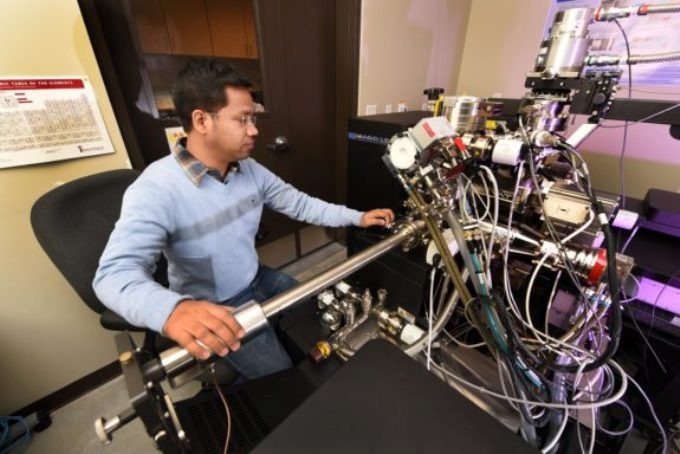Nov 19 2018
Scientists at Idaho National Laboratory have found out a way to make “superalloys” more super, prolonging their useful life for thousands of hours. The finding could enhance the performance of materials used in nuclear reactors and electrical generators. The solution is to heat and cool the superalloy in a unique way, which forms a microstructure within the material that can endure high heat over six times longer when compared to an untreated material.
“We came up with a way to make a superalloy that is much more resistant to heat-related failures. This could be useful in electricity generators and elsewhere,” said Subhashish Meher, an INL materials scientist, who was the lead author of a new paper describing the study published in Science Advances .
 INL materials scientist Subhashish Meher uses a local electron atom probe at the Center for Advanced Energy Studies to study the microstructure of treated superalloys. (Image credit: Idaho National Laboratory)
INL materials scientist Subhashish Meher uses a local electron atom probe at the Center for Advanced Energy Studies to study the microstructure of treated superalloys. (Image credit: Idaho National Laboratory)
Combinations of two or more metallic elements are known as alloys. Superalloys are extremely strong and exhibit other considerably enhanced characteristics because of the addition of trace amounts of elements such as cobalt, ruthenium, rhenium, and so on to a base metal. It is important to gain insights into ways for developing an improved superalloy for making the metallic mixture better for a specific purpose.
INL scientists have been investigating nickel-based superalloys. These superalloys have the ability to endure high heat and severe mechanical forces, hence they are useful for high-temperature nuclear reactor components and electricity-generating turbines. Earlier studies have demonstrated that it is possible to improve the performance if the superalloy’s material structure repeats in some way from very small sizes to very large, similar to a box within a box within a box.
This is known as a hierarchical microstructure. In the case of a superalloy, this microstructure is made up of a metallic matrix with precipitates, which are regions where the composition of the mixture varies from the rest of the metal. More finer-scale particles are embedded within the precipitates, where the particles have the same composition just like the matrix outside the precipitates—theoretically like nested boxes.
Meher and his colleagues examined the way these precipitates are created within a superalloy. They further studied how this structure endures heat and other treatments.
The research team discovered that with the appropriate recipe of heating and cooling, the precipitates could be made two or more times bigger than the original superalloys, thereby forming the desired microstructure. These larger precipitates survived longer when subjected to intense heat. Furthermore, computer simulation studies propose that the superalloy has the ability to resist heat-induced failure for 20,000 hours than about 3000 hours typically.
One possible application can be electrical generators that last considerably longer as the superalloy that they are made of would be stronger. Furthermore, INL researchers may now be in a position to invent a method that can be applied to other superalloys. Therefore, it may be feasible to regulate heat tolerance, strength, or other properties of superalloys to improve its use in a specific application.
We are now better able to dial in properties and improve material performance.
Subhashish Meher, Materials Scientist, INL.